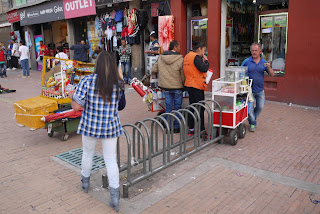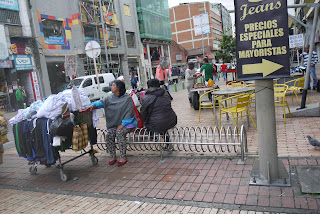 |
| For years, Plaza San Victorino has hosted this bike rack, which sometimes contains one or two bikes. |
Gustavo Petro, a one-time M-19 guerrilla leader, was Bogotá mayor from 2012 to '15, and now wants to be elected president.
From a cyclists perspective, his record is mixed.
Take a look at
Plaza San Victorino, which for years had a small bike rack which sometimes held one or two bicycles.
What was wrong with that? A lot, according to someone connected to the Petro administration, who decided that the plaza needed dozens and dozens more bike parking spots.
 |
| These Petro bike racks on Plaza San Victorino actually found users. |
 |
| But this one didn't. |
 |
| Finally, a bike in this rack. |
 |
| Another rack, around the corner, provides seating for tired street vendors. |
I guess you get the point. Petro's government issued a contract to install bike racks, but didn't care or didn't bother to check where they actually installed them. So, naturally, the contractor installed them where it was easiest and cheapest, not where they were useful.
Along the same lines, Petro's administration also issued a contract to create a public bicycle system - to a man who had no experience with bicycles and did have a history of corruption accusations, in a consortium with a Chinese company with not apparent experience with bicycles.
The contract was annulled by Mayor Peñalosa, and Bogotá still has no public bikes.
On the other hand, under Petro the city did build some useful bike lanes, called
ciclorutas.
 |
| A Petro-era cicloruta along El Parkway in Teusaquillo. |
Petro also created a
limited bike lending program, called
Bicicorredores, which lent bikes in six locations in Bogotá. Unfortunately, bikes borrowed in one location could not be returned in another, limiting the program's usefulness for transport. Mayor Peñalosa ended the program, calling it too expensive.
 |
| Public bikes lent out during the Petro administration, now parked for the long-term. |
Overall, Petro did some things for cyclists, but many of his initiatives were poorly thought-out or apparently full of corruption. All of which makes one question his sincerity and dedication.
